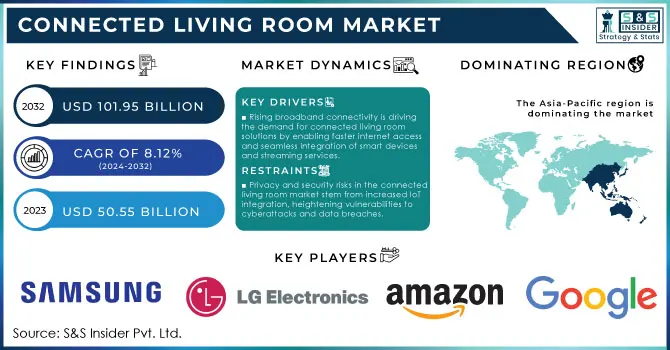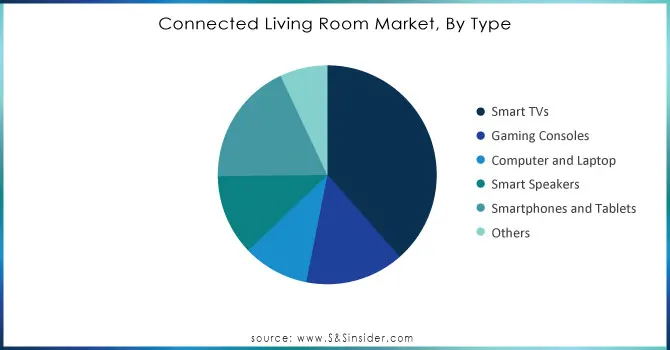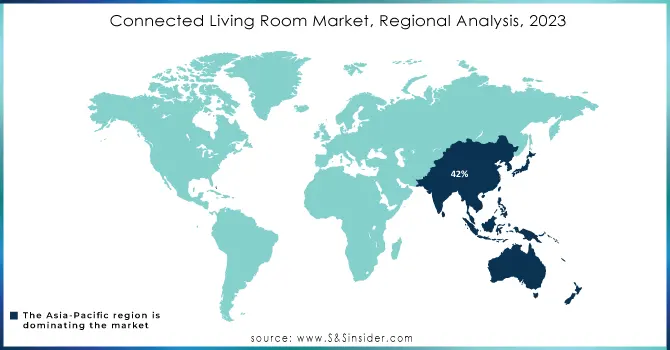Connected Living Room Market Size & Overview:

Get More Information on Connected Living Room Market - Request Sample Report
The Connected Living Room Market Size was valued at USD 50.55 billion in 2023 and is expected to reach USD 101.95 billion by 2032, and grow at a CAGR of 8.12% over the forecast period 2024-2032.
The connected living room market is expanding rapidly, driven by the growing demand for integrated home entertainment systems and the widespread adoption of smart home technologies. Devices such as smart TVs, voice-controlled speakers, gaming consoles, and advanced home theater systems are fueling this growth, along with the integration of AI, IoT, and voice recognition that enhance user automation and personalized content. Video streaming services like Netflix, Amazon Prime, and Disney+ are reshaping how consumers access entertainment, which in turn boosts the market. As of 2024, there are 5.35 billion internet users globally, representing about 66% of the population, a number expected to grow to 7.9 billion by 2029, a 47% increase. The growth of internet access, with 96.5% of people using mobile devices to connect online, directly affects the connected living room market, as more users embrace digital content streaming. Moreover, 80% of Americans have home broadband subscriptions, reflecting the necessity of fast, reliable internet for seamless access to entertainment in the connected home. This is further supported by the fact that 93% of rural areas, 97% of suburban, and 95% of urban Americans have internet access. With Google Chrome, holding 64% of the browser market and 59% of global web traffic coming from mobile, mobile internet usage is crucial for the growth of digital streaming and smart devices. Additionally, as 80% of people aged 60+ are projected to reside in low- and middle-income countries by 2050, the market for connected devices is expected to expand globally, particularly in regions that increasingly embrace technology. These trends all reflect the integral role of connectivity in shaping the future of entertainment and the growth of the connected living room market.
Connected Living Room Market Dynamics
Drivers
-
Rising broadband connectivity is driving the demand for connected living room solutions by enabling faster internet access and seamless integration of smart devices and streaming services.
The growing adoption of home broadband is significantly propelling the connected living room market. As 80% of Americans now subscribe to high-speed internet, this widespread access allows consumers to easily stream high-definition content, connect a range of devices, and embrace smart home technologies like smart TVs, voice-controlled speakers, and home theater systems. Ongoing infrastructure improvements, particularly in underserved regions, are enhancing broadband access. For example, initiatives in Norfolk, VA, and West Virginia aim to expand connectivity, empowering more households to enjoy faster internet speeds. This surge in broadband access directly boosts the demand for streaming services such as Netflix, Amazon Prime Video, and Disney+. With internet penetration expected to reach 98% of Americans, there will be an even greater demand for IoT devices and AI-driven home systems. As connected devices become integral to daily life, voice-activated technology and personalized content delivery are becoming key features of the connected living room, further driving market growth. Thus, broadband adoption plays a pivotal role in shaping the future of smart homes and entertainment systems.
Restraints
-
Privacy and security risks in the connected living room market arise from the increasing integration of IoT devices, which heightens vulnerabilities to cyberattacks and data breaches.
The growing integration of IoT devices in connected living rooms brings significant privacy and security concerns. With smart home devices like voice-controlled speakers and smart TVs collecting large amounts of personal data, consumers are at risk of cyberattacks and unauthorized access. These devices are vulnerable to breaches if not properly secured, as seen with concerns around data theft and unauthorized control. As consumer confidence is impacted, manufacturers must implement stronger security measures to address vulnerabilities. Until robust security standards and regulations are established, privacy concerns remain a major restraint on the connected living room market's growth.
Connected Living Room Market Segmentation Overview
By Type
In 2023, Smart TVs captured a significant 39% revenue share in the connected living room market, driven by technological innovations and rising demand for advanced entertainment. Leading brands such as Samsung, with its Neo QLED TVs, LG Electronics, with the OLED Evo G3 series, and Sony, with its BRAVIA XR series, have contributed to this growth through features like AI-driven picture enhancements, 4K and 8K support, and seamless integration with smart devices. TCL has also gained traction by offering affordable models with Roku TV and Google Assistant. These innovations, alongside growing streaming services and better internet speeds, ensure Smart TVs remain central to the connected living room ecosystem.

Need Any Customization Research On Connected Living Room Market - Inquiry Now
By Application
In 2023, video streaming captured a dominant 47% revenue share of the connected living room market. The shift from traditional cable TV to on-demand streaming services like Netflix, Amazon Prime Video, and Disney+ has driven the adoption of connected devices, particularly smart TVs. With advancements in broadband and internet speeds, consumers now enjoy seamless streaming of HD and 4K content. The rise of exclusive original content further fuels this growth. Companies like Netflix (with its affordable Basic with Ads) and Amazon Prime Video are enhancing their content libraries, making streaming even more appealing, solidifying video streaming as the largest application in the connected living room market.
Connected Living Room Market Regional Analysis
In 2023, Asia-Pacific captured a dominant 42% revenue share in the connected living room market, driven by urbanization, rising disposable incomes, and the growing adoption of smart home technologies. Consumer demand for advanced electronics like smart TVs, voice assistants, and streaming platforms has surged. Leading brands such as Samsung, LG Electronics, and Sony continue to innovate, with Samsung’s Neo QLED series, LG’s OLED Evo G3 series, and Sony’s BRAVIA XR series integrating advanced AI features. Local companies like TCL have gained market share with affordable, high-quality products. As broadband and streaming services expand, Asia-Pacific's leadership in this market is set to grow.
In 2023, North America emerged as the fastest-growing region in the connected living room market, driven by strong consumer spending on advanced entertainment products, robust internet infrastructure, and widespread smart home adoption. The region's demand for high-quality, seamless video streaming, along with the integration of smart TVs and IoT devices, fueled this growth. Companies like Samsung launched their Neo QLED series with Mini-LED and AI enhancements, while LG introduced its OLED Evo G3 series. Streaming services like Netflix, Amazon Prime Video, and Disney+ continue to thrive, further boosting the region’s expansion in smart home technology and connected entertainment.

Key Players in Connected Living Room Market
Some of the major players in Connected Living Room market with product:
-
Samsung Electronics (Smart TVs, Smart Speakers)
-
Sony Corporation (Smart TVs, Gaming Consoles)
-
LG Electronics (Smart TVs, Smart Speakers)
-
Apple Inc. (Apple TV, Apple HomePod)
-
Amazon (Amazon Fire TV, Amazon Echo)
-
Google LLC (Chromecast, Google Nest Audio)
-
Microsoft (Xbox Gaming Consoles, Microsoft Surface)
-
Roku, Inc. (Roku Streaming Players, Roku Smart TVs)
-
Vizio Inc. (Smart TVs, Soundbars)
-
TCL Corporation (Smart TVs, Smart Speakers)
-
Hisense (Smart TVs, Soundbars)
-
Harman International (Smart Speakers, Audio Systems)
-
NVIDIA Corporation (Shield TV, GeForce NOW Gaming)
-
Netflix (Video Streaming Service)
-
Spotify Technology (Audio Streaming Service)
-
Disney (Disney+ Streaming Service, Hulu)
-
Xiaomi (Smart TVs, Smart Speakers)
-
Alibaba Group (Tmall Genie Smart Speakers, TV Streaming)
-
Sky Group (Sky Q, Sky Glass Smart TV)
-
Philips (Smart TVs, Hue Smart Lighting)
List of some of the major suppliers in the Connected Living Room Market, including suppliers of hardware components (like smart TVs, speakers, gaming consoles) and services (like streaming and cloud platforms):
-
Foxconn Technology Group
-
Qualcomm
-
MediaTek
-
Broadcom
-
Intel Corporation
-
AMD (Advanced Micro Devices)
-
Vizio Inc.
-
Harman International
-
Panasonic
-
LG Electronics
-
Samsung Electronics
-
TCL Corporation
-
Hisense
-
Sony Corporation
-
Roku Inc.
-
Google LLC
-
Amazon
-
Apple Inc.
-
Xiaomi
-
NVIDIA Corporation
Recent Development
-
On September 3, 2024, a new guide to smart home technology was published, offering insights on how to control and monitor your property from anywhere with connected gadgets. The guide highlights innovative solutions for enhancing home automation room-by-room, making it easier to integrate smart technology into everyday living.
-
On October 1, 2024, Ashley and Samsung launched The Connected Home Experience at Ashley’s flagship store in Brentwood, Tennessee, showcasing how smart technology integrates with stylish furnishings. Using Samsung Galaxy Tab S9 FE+, visitors can interact with the SmartThings ecosystem to create customizable living spaces, with the ability to control devices like The Frame TV and Galaxy Tab S9 FE+ for an immersive home experience.
| Report Attributes | Details |
|---|---|
| Market Size in 2023 | USD 50.55 Billion |
| Market Size by 2032 | USD 101.95 Billion |
| CAGR | CAGR of 8.12% From 2024 to 2032 |
| Base Year | 2023 |
| Forecast Period | 2024-2032 |
| Historical Data | 2020-2022 |
| Report Scope & Coverage | Market Size, Segments Analysis, Competitive Landscape, Regional Analysis, DROC & SWOT Analysis, Forecast Outlook |
| Key Segments | • By Type (Smart TVs, Gaming Consoles, Computer and Laptop, Smart Speakers, Smartphones and Tablets, Others) • By Technology (Wi-Fi, Bluetooth, Others) • By Application(Video Streaming, Audio Streaming, Gaming, Security, Others) |
| Regional Analysis/Coverage | North America (US, Canada, Mexico), Europe (Eastern Europe [Poland, Romania, Hungary, Turkey, Rest of Eastern Europe] Western Europe] Germany, France, UK, Italy, Spain, Netherlands, Switzerland, Austria, Rest of Western Europe]), Asia-Pacific (China, India, Japan, South Korea, Vietnam, Singapore, Australia, Rest of Asia-Pacific), Middle East & Africa (Middle East [UAE, Egypt, Saudi Arabia, Qatar, Rest of Middle East], Africa [Nigeria, South Africa, Rest of Africa], Latin America (Brazil, Argentina, Colombia, Rest of Latin America) |
| Company Profiles | Samsung Electronics, Sony Corporation, LG Electronics, Apple Inc., Amazon, Google LLC, Microsoft, Roku, Inc., Vizio Inc., TCL Corporation, Hisense, Harman International, NVIDIA Corporation, Netflix, Spotify Technology, Disney, Xiaomi, Alibaba Group, Sky Group, and Philips are key players in the connected living room market. |
| Key Drivers | • Rising broadband connectivity is driving the demand for connected living room solutions |
| RESTRAINTS | • Privacy and security risks in the connected living room market |

